Fuchen Long
Region-Constraint In-Context Generation for Instructional Video Editing
Dec 19, 2025Abstract:The In-context generation paradigm recently has demonstrated strong power in instructional image editing with both data efficiency and synthesis quality. Nevertheless, shaping such in-context learning for instruction-based video editing is not trivial. Without specifying editing regions, the results can suffer from the problem of inaccurate editing regions and the token interference between editing and non-editing areas during denoising. To address these, we present ReCo, a new instructional video editing paradigm that novelly delves into constraint modeling between editing and non-editing regions during in-context generation. Technically, ReCo width-wise concatenates source and target video for joint denoising. To calibrate video diffusion learning, ReCo capitalizes on two regularization terms, i.e., latent and attention regularization, conducting on one-step backward denoised latents and attention maps, respectively. The former increases the latent discrepancy of the editing region between source and target videos while reducing that of non-editing areas, emphasizing the modification on editing area and alleviating outside unexpected content generation. The latter suppresses the attention of tokens in the editing region to the tokens in counterpart of the source video, thereby mitigating their interference during novel object generation in target video. Furthermore, we propose a large-scale, high-quality video editing dataset, i.e., ReCo-Data, comprising 500K instruction-video pairs to benefit model training. Extensive experiments conducted on four major instruction-based video editing tasks demonstrate the superiority of our proposal.
HiDream-I1: A High-Efficient Image Generative Foundation Model with Sparse Diffusion Transformer
May 28, 2025Abstract:Recent advancements in image generative foundation models have prioritized quality improvements but often at the cost of increased computational complexity and inference latency. To address this critical trade-off, we introduce HiDream-I1, a new open-source image generative foundation model with 17B parameters that achieves state-of-the-art image generation quality within seconds. HiDream-I1 is constructed with a new sparse Diffusion Transformer (DiT) structure. Specifically, it starts with a dual-stream decoupled design of sparse DiT with dynamic Mixture-of-Experts (MoE) architecture, in which two separate encoders are first involved to independently process image and text tokens. Then, a single-stream sparse DiT structure with dynamic MoE architecture is adopted to trigger multi-model interaction for image generation in a cost-efficient manner. To support flexiable accessibility with varied model capabilities, we provide HiDream-I1 in three variants: HiDream-I1-Full, HiDream-I1-Dev, and HiDream-I1-Fast. Furthermore, we go beyond the typical text-to-image generation and remould HiDream-I1 with additional image conditions to perform precise, instruction-based editing on given images, yielding a new instruction-based image editing model namely HiDream-E1. Ultimately, by integrating text-to-image generation and instruction-based image editing, HiDream-I1 evolves to form a comprehensive image agent (HiDream-A1) capable of fully interactive image creation and refinement. To accelerate multi-modal AIGC research, we have open-sourced all the codes and model weights of HiDream-I1-Full, HiDream-I1-Dev, HiDream-I1-Fast, HiDream-E1 through our project websites: https://github.com/HiDream-ai/HiDream-I1 and https://github.com/HiDream-ai/HiDream-E1. All features can be directly experienced via https://vivago.ai/studio.
MotionPro: A Precise Motion Controller for Image-to-Video Generation
May 26, 2025



Abstract:Animating images with interactive motion control has garnered popularity for image-to-video (I2V) generation. Modern approaches typically rely on large Gaussian kernels to extend motion trajectories as condition without explicitly defining movement region, leading to coarse motion control and failing to disentangle object and camera moving. To alleviate these, we present MotionPro, a precise motion controller that novelly leverages region-wise trajectory and motion mask to regulate fine-grained motion synthesis and identify target motion category (i.e., object or camera moving), respectively. Technically, MotionPro first estimates the flow maps on each training video via a tracking model, and then samples the region-wise trajectories to simulate inference scenario. Instead of extending flow through large Gaussian kernels, our region-wise trajectory approach enables more precise control by directly utilizing trajectories within local regions, thereby effectively characterizing fine-grained movements. A motion mask is simultaneously derived from the predicted flow maps to capture the holistic motion dynamics of the movement regions. To pursue natural motion control, MotionPro further strengthens video denoising by incorporating both region-wise trajectories and motion mask through feature modulation. More remarkably, we meticulously construct a benchmark, i.e., MC-Bench, with 1.1K user-annotated image-trajectory pairs, for the evaluation of both fine-grained and object-level I2V motion control. Extensive experiments conducted on WebVid-10M and MC-Bench demonstrate the effectiveness of MotionPro. Please refer to our project page for more results: https://zhw-zhang.github.io/MotionPro-page/.
Ouroboros-Diffusion: Exploring Consistent Content Generation in Tuning-free Long Video Diffusion
Jan 15, 2025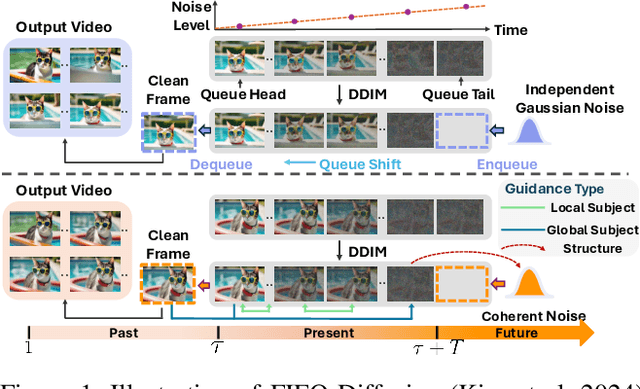



Abstract:The first-in-first-out (FIFO) video diffusion, built on a pre-trained text-to-video model, has recently emerged as an effective approach for tuning-free long video generation. This technique maintains a queue of video frames with progressively increasing noise, continuously producing clean frames at the queue's head while Gaussian noise is enqueued at the tail. However, FIFO-Diffusion often struggles to keep long-range temporal consistency in the generated videos due to the lack of correspondence modeling across frames. In this paper, we propose Ouroboros-Diffusion, a novel video denoising framework designed to enhance structural and content (subject) consistency, enabling the generation of consistent videos of arbitrary length. Specifically, we introduce a new latent sampling technique at the queue tail to improve structural consistency, ensuring perceptually smooth transitions among frames. To enhance subject consistency, we devise a Subject-Aware Cross-Frame Attention (SACFA) mechanism, which aligns subjects across frames within short segments to achieve better visual coherence. Furthermore, we introduce self-recurrent guidance. This technique leverages information from all previous cleaner frames at the front of the queue to guide the denoising of noisier frames at the end, fostering rich and contextual global information interaction. Extensive experiments of long video generation on the VBench benchmark demonstrate the superiority of our Ouroboros-Diffusion, particularly in terms of subject consistency, motion smoothness, and temporal consistency.
TRIP: Temporal Residual Learning with Image Noise Prior for Image-to-Video Diffusion Models
Mar 25, 2024Abstract:Recent advances in text-to-video generation have demonstrated the utility of powerful diffusion models. Nevertheless, the problem is not trivial when shaping diffusion models to animate static image (i.e., image-to-video generation). The difficulty originates from the aspect that the diffusion process of subsequent animated frames should not only preserve the faithful alignment with the given image but also pursue temporal coherence among adjacent frames. To alleviate this, we present TRIP, a new recipe of image-to-video diffusion paradigm that pivots on image noise prior derived from static image to jointly trigger inter-frame relational reasoning and ease the coherent temporal modeling via temporal residual learning. Technically, the image noise prior is first attained through one-step backward diffusion process based on both static image and noised video latent codes. Next, TRIP executes a residual-like dual-path scheme for noise prediction: 1) a shortcut path that directly takes image noise prior as the reference noise of each frame to amplify the alignment between the first frame and subsequent frames; 2) a residual path that employs 3D-UNet over noised video and static image latent codes to enable inter-frame relational reasoning, thereby easing the learning of the residual noise for each frame. Furthermore, both reference and residual noise of each frame are dynamically merged via attention mechanism for final video generation. Extensive experiments on WebVid-10M, DTDB and MSR-VTT datasets demonstrate the effectiveness of our TRIP for image-to-video generation. Please see our project page at https://trip-i2v.github.io/TRIP/.
Learning Spatial Adaptation and Temporal Coherence in Diffusion Models for Video Super-Resolution
Mar 25, 2024
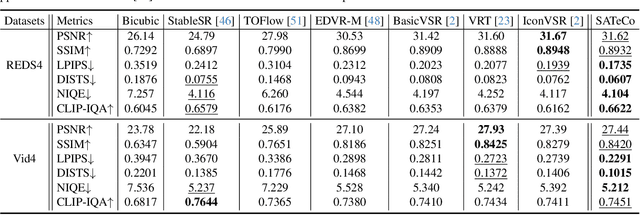

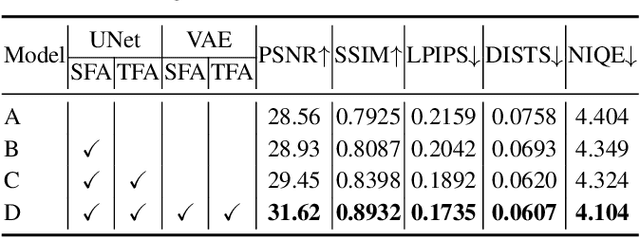
Abstract:Diffusion models are just at a tipping point for image super-resolution task. Nevertheless, it is not trivial to capitalize on diffusion models for video super-resolution which necessitates not only the preservation of visual appearance from low-resolution to high-resolution videos, but also the temporal consistency across video frames. In this paper, we propose a novel approach, pursuing Spatial Adaptation and Temporal Coherence (SATeCo), for video super-resolution. SATeCo pivots on learning spatial-temporal guidance from low-resolution videos to calibrate both latent-space high-resolution video denoising and pixel-space video reconstruction. Technically, SATeCo freezes all the parameters of the pre-trained UNet and VAE, and only optimizes two deliberately-designed spatial feature adaptation (SFA) and temporal feature alignment (TFA) modules, in the decoder of UNet and VAE. SFA modulates frame features via adaptively estimating affine parameters for each pixel, guaranteeing pixel-wise guidance for high-resolution frame synthesis. TFA delves into feature interaction within a 3D local window (tubelet) through self-attention, and executes cross-attention between tubelet and its low-resolution counterpart to guide temporal feature alignment. Extensive experiments conducted on the REDS4 and Vid4 datasets demonstrate the effectiveness of our approach.
VideoDrafter: Content-Consistent Multi-Scene Video Generation with LLM
Jan 02, 2024
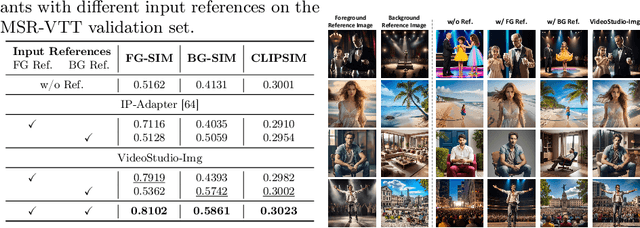


Abstract:The recent innovations and breakthroughs in diffusion models have significantly expanded the possibilities of generating high-quality videos for the given prompts. Most existing works tackle the single-scene scenario with only one video event occurring in a single background. Extending to generate multi-scene videos nevertheless is not trivial and necessitates to nicely manage the logic in between while preserving the consistent visual appearance of key content across video scenes. In this paper, we propose a novel framework, namely VideoDrafter, for content-consistent multi-scene video generation. Technically, VideoDrafter leverages Large Language Models (LLM) to convert the input prompt into comprehensive multi-scene script that benefits from the logical knowledge learnt by LLM. The script for each scene includes a prompt describing the event, the foreground/background entities, as well as camera movement. VideoDrafter identifies the common entities throughout the script and asks LLM to detail each entity. The resultant entity description is then fed into a text-to-image model to generate a reference image for each entity. Finally, VideoDrafter outputs a multi-scene video by generating each scene video via a diffusion process that takes the reference images, the descriptive prompt of the event and camera movement into account. The diffusion model incorporates the reference images as the condition and alignment to strengthen the content consistency of multi-scene videos. Extensive experiments demonstrate that VideoDrafter outperforms the SOTA video generation models in terms of visual quality, content consistency, and user preference.
Dynamic Temporal Filtering in Video Models
Nov 15, 2022Abstract:Video temporal dynamics is conventionally modeled with 3D spatial-temporal kernel or its factorized version comprised of 2D spatial kernel and 1D temporal kernel. The modeling power, nevertheless, is limited by the fixed window size and static weights of a kernel along the temporal dimension. The pre-determined kernel size severely limits the temporal receptive fields and the fixed weights treat each spatial location across frames equally, resulting in sub-optimal solution for long-range temporal modeling in natural scenes. In this paper, we present a new recipe of temporal feature learning, namely Dynamic Temporal Filter (DTF), that novelly performs spatial-aware temporal modeling in frequency domain with large temporal receptive field. Specifically, DTF dynamically learns a specialized frequency filter for every spatial location to model its long-range temporal dynamics. Meanwhile, the temporal feature of each spatial location is also transformed into frequency feature spectrum via 1D Fast Fourier Transform (FFT). The spectrum is modulated by the learnt frequency filter, and then transformed back to temporal domain with inverse FFT. In addition, to facilitate the learning of frequency filter in DTF, we perform frame-wise aggregation to enhance the primary temporal feature with its temporal neighbors by inter-frame correlation. It is feasible to plug DTF block into ConvNets and Transformer, yielding DTF-Net and DTF-Transformer. Extensive experiments conducted on three datasets demonstrate the superiority of our proposals. More remarkably, DTF-Transformer achieves an accuracy of 83.5% on Kinetics-400 dataset. Source code is available at \url{https://github.com/FuchenUSTC/DTF}.
Bi-Calibration Networks for Weakly-Supervised Video Representation Learning
Jun 21, 2022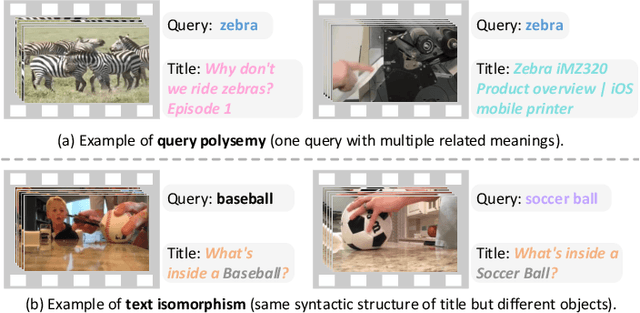



Abstract:The leverage of large volumes of web videos paired with the searched queries or surrounding texts (e.g., title) offers an economic and extensible alternative to supervised video representation learning. Nevertheless, modeling such weakly visual-textual connection is not trivial due to query polysemy (i.e., many possible meanings for a query) and text isomorphism (i.e., same syntactic structure of different text). In this paper, we introduce a new design of mutual calibration between query and text to boost weakly-supervised video representation learning. Specifically, we present Bi-Calibration Networks (BCN) that novelly couples two calibrations to learn the amendment from text to query and vice versa. Technically, BCN executes clustering on all the titles of the videos searched by an identical query and takes the centroid of each cluster as a text prototype. The query vocabulary is built directly on query words. The video-to-text/video-to-query projections over text prototypes/query vocabulary then start the text-to-query or query-to-text calibration to estimate the amendment to query or text. We also devise a selection scheme to balance the two corrections. Two large-scale web video datasets paired with query and title for each video are newly collected for weakly-supervised video representation learning, which are named as YOVO-3M and YOVO-10M, respectively. The video features of BCN learnt on 3M web videos obtain superior results under linear model protocol on downstream tasks. More remarkably, BCN trained on the larger set of 10M web videos with further fine-tuning leads to 1.6%, and 1.8% gains in top-1 accuracy on Kinetics-400, and Something-Something V2 datasets over the state-of-the-art TDN, and ACTION-Net methods with ImageNet pre-training. Source code and datasets are available at \url{https://github.com/FuchenUSTC/BCN}.
Stand-Alone Inter-Frame Attention in Video Models
Jun 14, 2022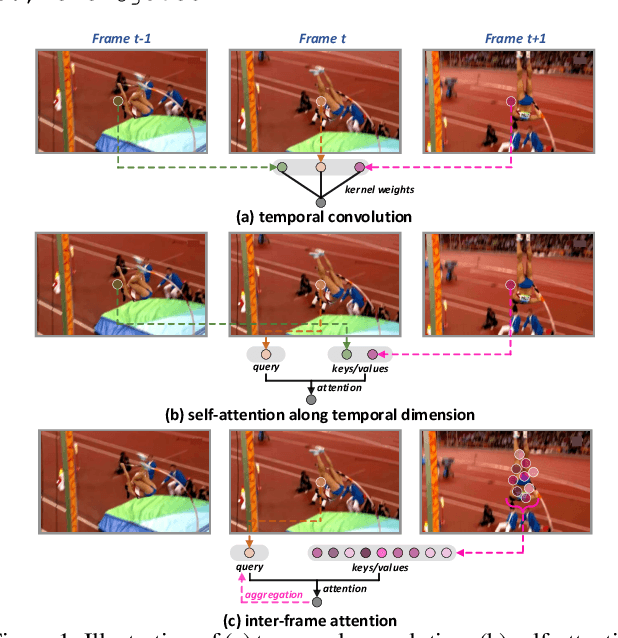
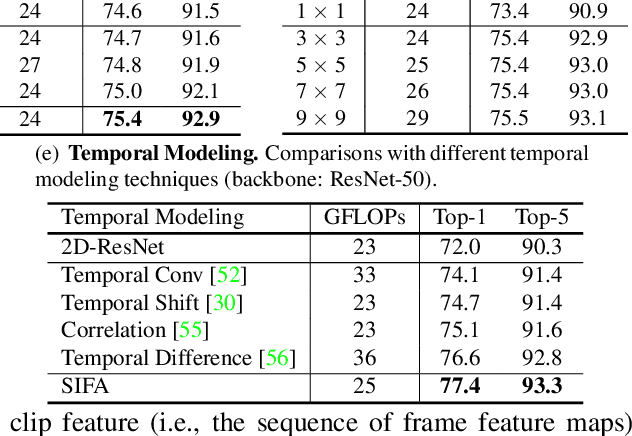
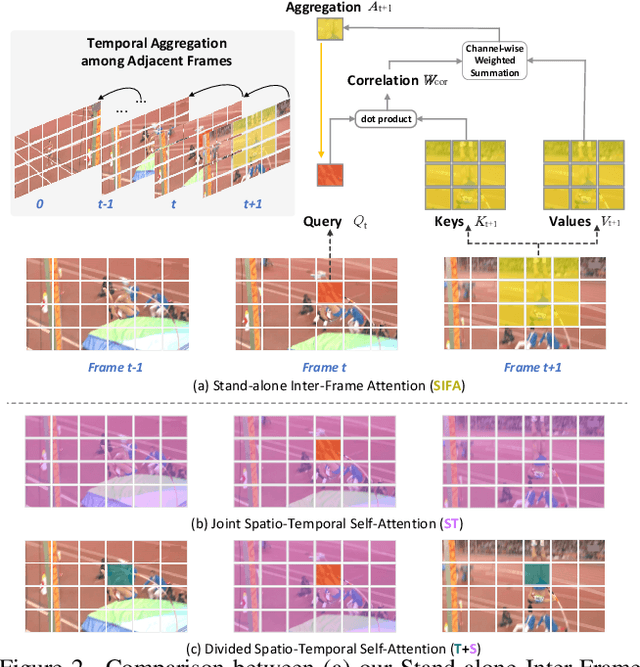
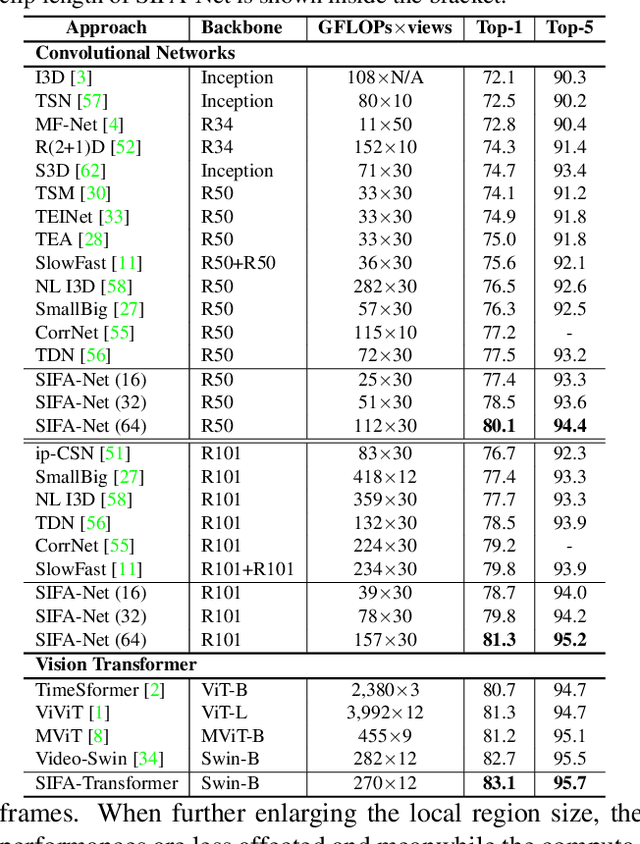
Abstract:Motion, as the uniqueness of a video, has been critical to the development of video understanding models. Modern deep learning models leverage motion by either executing spatio-temporal 3D convolutions, factorizing 3D convolutions into spatial and temporal convolutions separately, or computing self-attention along temporal dimension. The implicit assumption behind such successes is that the feature maps across consecutive frames can be nicely aggregated. Nevertheless, the assumption may not always hold especially for the regions with large deformation. In this paper, we present a new recipe of inter-frame attention block, namely Stand-alone Inter-Frame Attention (SIFA), that novelly delves into the deformation across frames to estimate local self-attention on each spatial location. Technically, SIFA remoulds the deformable design via re-scaling the offset predictions by the difference between two frames. Taking each spatial location in the current frame as the query, the locally deformable neighbors in the next frame are regarded as the keys/values. Then, SIFA measures the similarity between query and keys as stand-alone attention to weighted average the values for temporal aggregation. We further plug SIFA block into ConvNets and Vision Transformer, respectively, to devise SIFA-Net and SIFA-Transformer. Extensive experiments conducted on four video datasets demonstrate the superiority of SIFA-Net and SIFA-Transformer as stronger backbones. More remarkably, SIFA-Transformer achieves an accuracy of 83.1% on Kinetics-400 dataset. Source code is available at \url{https://github.com/FuchenUSTC/SIFA}.
 Add to Chrome
Add to Chrome Add to Firefox
Add to Firefox Add to Edge
Add to Edge